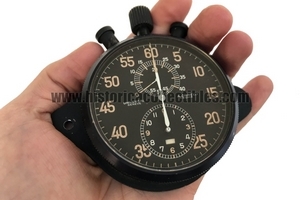Clock HC-1 Timepiece Universal Geneve "Cairelli" for Fiat G91, circa 1960
Type HC-1 timepiece, produced in 1960 by Cairelli-Rome, using the mechanism of Universal Geneve. This particular clock was made to be installed on board the Fiat G91 plane, a fighter-bomber-reconnaissance aircraft of the Italian Air Force: a plate placed on the back shows the military registration number.
The clock was dedicated solely to computation of total elapsed time for air navigation purposes.
Universal Genève was founded in 1894 by Audemars Piguet, Girard-Perregaux, Patek Philippe and Rolex: on 18 January of that year, watchmaking students Numa-Emile Descombes (31 years old) and Ulysse Georges Perret (26 years old) registered the brand in the Swiss municipality Le Locle, where the company had its first headquarters. In that same location, he began producing cases, dials, crowns and movements, entirely managing the creation of the mechanisms.
After Descombes' death in 1897, Perret recruited Louis Berthoud and the firm was called "Pierre & Berthoud" for a short time.
In 1898, the brand gained notoriety first in Europe and subsequently also in the United States, producing the first manually wound chronographs with a 30-minute counter. The first pocket and "trench" models were also born in that period, produced during the First World War for both factions.
The company was moved to Geneva in 1919.
In 1925, after years of experimentation, “Auto-Rem” was produced, the company's first self-winding model.
In 1933 Ulysse Georges Perret died. His successor was his son Raoul, who changed the name of the company to Universal Watch Co. Ltd. It was the year of the production of the Compur chronograph, which was followed, three years later, by the Aero Compax. The company moved again in 1935, but without abandoning the city: the new headquarters was in Rue du Rhône, next to Patek Philippe.
In the same year, the company was reregistered under the name Universal Genève.
The house soon attracted international attention and began a collaboration with the fashion house Hermès, producing the “Pour Hermès” square button chronograph. In 1939, Universal Genève received a royal warrant to supply watches to the Dutch army, with the initials of Queen Wilhelmina of the Netherlands embossed on the dial. The supply was continued until 1944, when the Nazis invaded Rotterdam. The difficulties of the period did not undermine the growing popularity of the company, which in 1941 opened a new headquarters in Les Ponts-de-Martel, entirely dedicated to the production of chronographs.
On March 3, 1947, Louis-Eduard Berthoud died, without being able to see the birth of the Caliber 38 unidirectional self-winding mechanical movement and the subsequent models, which contributed to the growth of the brand's prestige and which resulted in a second generation, the Caliber 66 and 67 , holders of the record for the thinnest automatic watches in the world until 1978 (2.3 mm).
Research and experimentation also characterized the Sixties and Seventies, which saw the birth of the first electro-mechanical watches designed in collaboration with Movado and the thinnest quartz watch in the world. The 1980s, however, were marked by an important turning point: for the first time in 30 years, the presidency went to a member from outside the family, Lennard Oldman. His leadership, however, was short-lived: in 1989 the Hong Kong group Stelux Holdings International Ltd took over from him.
After several moves, the company arrived at its current headquarters in Geneva-Acacias. Since 2011, Universal Genève has been a full member of the Federation of the Swiss Watch Industry, with three offices in Switzerland also managing Cyma, previously taken over by the Stelux Holdings International Ltd group.

